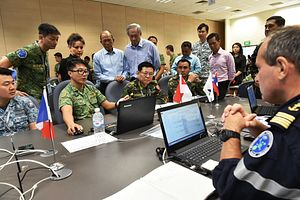This week, representatives from 18 militaries gathered in Singapore for an exercise designed to strengthen cooperation in the area of humanitarian assistance and disaster relief (HADR). Exercise Coordinated Response (Ex COORES) 2017, which was organized by Singapore, the Philippines, and the United States, occurred from January 23 to 25 and is notable for several reasons (See: “ASEAN in the Spotlight in Philippine Defense Chief’s First Singapore Visit“).
First, the exercise is testament to the fact that even though media attention on regional security issues tends to be overwhelmingly focused on flashpoints like the South China Sea, other challenges like natural disasters are significant too. Southeast Asia is one of the world’s most disaster-prone subregions, and the region has been working on fostering greater regional cooperation in the HADR field to better prepare itself for these disasters. Last September, at the 28th ASEAN Summit held in Vientiane, ASEAN leaders signed an ASEAN Declaration on One ASEAN, One Response to achieve a faster and collective response to disasters (See: “US Group to Boost ASEAN Disaster Relief Capabilities”).
Second, Ex COORES also highlights Singapore’s importance as a hub on the regional HADR issue. This was the first multinational HADR exercise hosted by the Changi Regional HADR Coordination Center (RHCC) since it was launched in September 2014. Though the RHCC is only one component of the regional architecture around HADR in Southeast Asia, it is nonetheless an important one in disaster preparedness. The RHCC’s operations include day-to-day monitoring, sharing of information, and planning on regional disasters; supporting disaster relief efforts through situation updates, coordination, and deployment of teams and mobile coordination units; and capacity-building efforts like workshops, forums, trainings, and exercises.
The regional role of the RHCC was evident during the execution of Ex COORES itself, which was based around a scenario simulating two major disasters striking the Philippines in succession: a volcanic eruption at Mount Mayon followed by a Category 5 typhoon in the city of Legazpi. The RHCC sent an advance team to support the Philippine military’s establishment of a multinational coordination center (MNCC) to coordinate incoming foreign assistance, which allowed militaries as well as civilian agencies to familiarize themselves with its concept of operations in anticipation of future HADR operations.
Third and finally, the exercise was also a good example of the growing cooperation between the United States and its allies and partners in Southeast Asia on HADR. Ex COORES was done with the Singapore Armed Forces’ (SAF’s) RHCC along with the Armed Forces of the Philippines (AFP) and the United States Center for Excellence in Disaster Management and Humanitarian Assistance (CFE-DM). In a sign of growing cooperation between the United States and Singapore, on the sidelines of Ex COORES, the director of Changi RHCC, Colonel Lee Kuan Chung, and the director of CFE-DM, Joseph D. Martin, inked a memorandum of understanding to establish a framework for cooperation between the two bodies.
Singapore’s defense ministry (MINDEF) said in a statement that the MoU “demonstrates Singapore’s and the U.S.’s shared intent to foster a strategic partnership and build regional capacity in HADR.” It also referred to the fact that HADR was one of the areas where both sides were looking to make progress following the signing of a new enhanced Defense Cooperation Agreement (DCA) in 2015 (See: “Advancing the US-Singapore Strategic Partnership”).
































